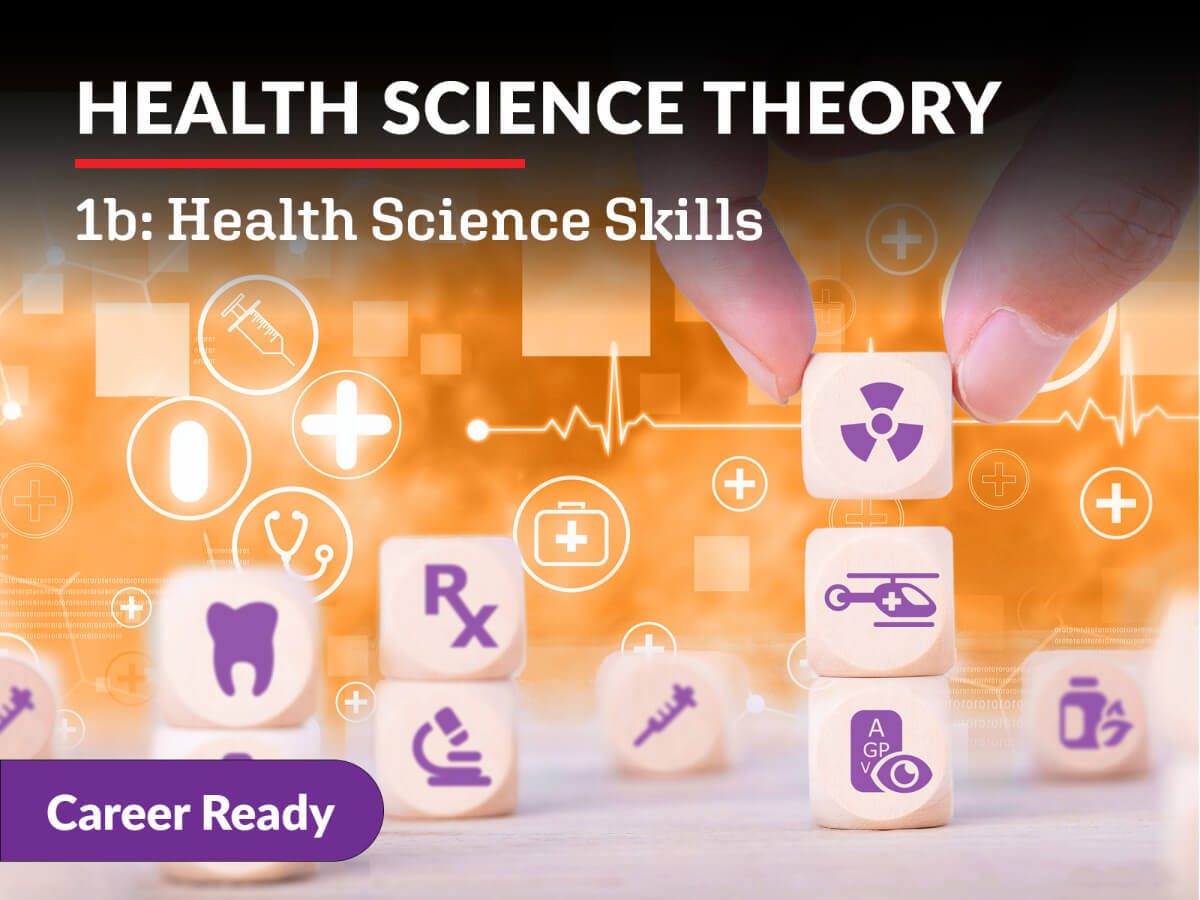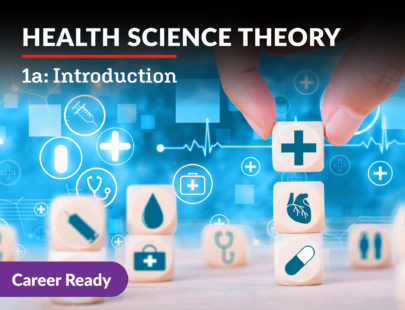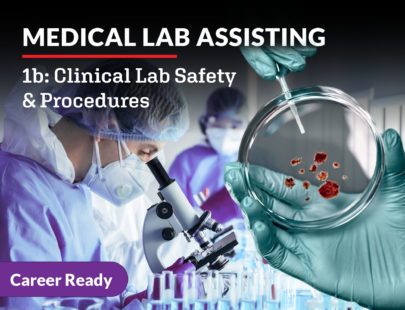
Health Science Theory 1b: Health Science Skills
You’ve built a solid foundation of knowledge of the healthcare field, and now it’s time to probe deeper into the healthcare profession. In this course, you’ll review key aspects of the broad category of safety as well as learn how to assess and treat patients for an array of injuries. You’ll learn how to identify emergencies, trauma and complex care, and the basics of CPR and life support. Lastly, you’ll explore the importance of collaborating with other team members to manage and resolve conflicts. Let’s suit up to learn how you can positively impact patients in the field of healthcare.
Units at a Glance
Unit 1: Safety in the Workplace
We know healthcare professionals perform job-specific skills, communicate with patients, and exhibit compassion each day, but who is responsible for keeping patients safe? The answer may surprise you! Anyone working in a healthcare facility plays a role in keeping the environment safe for everyone: patients, workers, and visitors. As we explore what it takes to maintain a safe workplace, we’ll investigate the types of hazards in these environments and the actions we need to take to protect everyone.
What will you learn in this unit?
- Describe organizations that provide safety guidelines for healthcare institutions, along with examples of patient safety goals
- Identify ways to comply with environmental safety guidelines
- Explain types of hazardous materials and waste found within a healthcare facility
- Analyze ways to reduce the healthcare worker’s risk of injury in the workplace
Unit 2: Documentation
Healthcare providers perform many job-specific tasks as they care for patients. One often overlooked but very important task is documentation. In the healthcare world, it’s often said that if something isn’t documented, it didn’t happen. When dealing with patient welfare, it’s critical to track every move taken throughout the care process to know what was done along the way. As we explore this topic, we’ll look at various types of documentation and methods to ensure accuracy no matter what profession you’re in.
What will you learn in this unit?
- Differentiate between paper and electronic record systems and identify the importance of health information technology
- Describe security measures used to protect health information and how HIPAA influences this protection
- Identify the parts of a medical record
- Analyze other systems used when documenting health information
Unit 3: On the Job
Think about some of the job responsibilities of the allied health professionals we’ve learned about so far. Each profession has some skills unique to that field, while other skills overlap from one profession to another. As we begin to look at skills used in direct patient interaction, we’ll investigate those needed by all professionals, like patient admitting and discharge requirements, communicating effectively in various situations, and patient movement and positioning. After examining these types of skills, we’ll narrow our focus to more specific ones, like assisting patients with daily living tasks and assessing patients’ range of motion. Ready to get on the job? Let’s learn more about the skills you’ll need!
What will you learn in this unit?
- Define functions related to patient admission, transfer, and discharge
- Identify methods for moving patients for treatment or examination
- Analyze patient positions and proper use of support devices
- Describe skills related to assisting patients with activities of daily living
Unit 4: Collaboration in Health Care
Although most of the time we think about each healthcare professional as an individual performing functions independently, everyone in the medical world is actually part of a team. Think about how complex the human body is, with all of the systems working together to maintain everyday functions. Just like the various systems work together for a common goal, so do healthcare workers! No matter which healthcare profession you choose, being a valuable team member and knowing how to collaborate with other professionals puts you on the path to a successful career.
What will you learn in this unit?
- Describe the members that make up a team and the principles of collaboration
- Assess team dynamics, including team roles and the stages of team development
- Analyze effective conflict resolution techniques in healthcare settings
- Identify leadership skills of healthcare professionals
Unit 5: Responding First
From a scraped knee and a bee sting to foreign bodies and open wounds, healthcare workers need to learn all types of skills to care for patients outside and inside medical facilities. The steps they take to care for patients when injuries happen are all first aid. Although most of us know how to deal with minor issues like a scraped knee or bug bite, we may not know how to deal with other types of wounds. Healthcare professionals need to be prepared to not only respond to all types of injuries but also react when things don’t go as planned. As we explore what it takes to respond first, we’ll analyze the steps and the skills needed to care for patients in a variety of non-trauma situations.
What will you learn in this unit?
- Define the role of healthcare professionals in providing first aid
- Identify first aid skills used in treating bites, blisters, and bruises
- Explain first aid skills used in treating cuts, foreign bodies, and puncture wounds
- Describe the steps used when performing venipuncture
Unit 6: Recognizing and Reacting to Emergencies
Healthcare professionals of all specialties must be prepared to handle any type of emergency that arises inside and outside of a medical facility. To be ready to react, they need to understand and differentiate between what’s normal and what needs immediate attention. As we explore how to recognize an emergency, we’ll investigate how the body maintains its constant balance of biologic and chemical processes. We’ll also examine the signs and symptoms to look for when that balance is disrupted. By recognizing these signs and symptoms, we’ll be ready to react with emergency treatments such as performing CPR, using an AED, and clearing airway obstructions.
What will you learn in this unit?
- Explain how the body works to maintain homeostasis
- Identify normal and abnormal signs and symptoms as they relate to an emergency
- Describe how to perform CPR and use an AED
- Define the AHA chain of survival and how to dislodge a foreign body obstruction
Unit 7: Trauma and Complex Care
Do you have what it takes to think quickly and make complex decisions related to emergency situations? How well do you adapt when a situation changes or when something doesn’t go as planned? During our exploration into trauma and complex care, we’ll see how the body changes with various conditions and investigate ways to care for patients in different situations. Additionally, we’ll discover the importance of assessing each emergent situation and adjusting decisions to reach the best possible outcome for the patient. As we’re about to learn, treating trauma isn’t just about the condition, it’s about problem-solving and adapting to the situation.
What will you learn in this unit?
- Define trauma and complex care along with the importance of critical thinking in these situations
- Explain how blood flow conditions cause changes in the body that result in the need for emergent care
- Describe the impact of exposure to heat or cold on the body
- Identify types of bone and joint injuries as well as the first steps in treating them
Unit 8: What’s Next?
The world of health sciences includes a wide variety of occupations, making it possible for people to choose a career path best suited to their interests. The skills and educational training required for each career provide a foundation for pursuing that dream job. As we explore what’s next, we’ll review written and oral communication skills as they apply to the job search, including preparing application documents and interviewing. We’ll also focus on how to find job opportunities and narrow down that search. To complete the process, we’ll investigate training opportunities and the importance of staying active in the profession. With so much knowledge about health sciences, we’re ready to explore what’s next!
What will you learn in this unit?
- Research educational requirements and certification and licensure by profession and location
- Create a resume and cover letter to prepare for employment opportunities
- Complete steps in obtaining employment including conducting a job search, preparing for an interview, and completing employment procedures
- Analyze the importance of professional organizations and potential areas of career advancement in the health sciences
Required Materials
Physical
- Video recording device
- Writing supplies
Software
- Presentation software
- Word processing software
Optional
- Art supplies
- Audio recording device
- Colored pencils
- Digital camera
- Graphic design software
- Helper
- Household items
- Image editing software
- Printer
- Video recording device



